
manager for the City of Copenhagen,
Andreas Rohl.
(Photos © J. Maus)
The 2009 National Bike Summit kicked off tonight with a pep rally of sorts, and the head cheerleader was Andreas Rohl, bike program manager for the city of Copenhagen.
For the uninitiated, Copenhagen is the world class cycling city all others aspire to. Don’t believe that claim? 36% of people who enter the city for work or for school do so on a bicycle and among people who live in their city’s core, 55% bike to work.
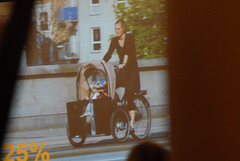
in Copenhagen recently. An “interesting
planning problem” says Rohl.
Before his keynote speech in front of an estimated 4-500 summit attendees, I joined Rohl and about 30 other people at a smaller reception here at the Reagan International Trade Center on Pennsylvania Avenue. When I first approached Rohl, he was busily chatting with none other than his Portland counterpart — city bike coordinator Roger Geller.
Roger and I were both interested to hear what challenges (if any) Mr. Rohl faces in his bike utopia. One of the first things he mentioned was the expansion of their Metro (trains) system. He called it “the greatest threat to the public health of Copenhagen,” because of how it would contribute to less active transportation. (With his accent, I’m not quite sure if he was serious or not, but I think he was.)
On a more serious note, Rohl said that he is working hard to make their bike facilities more “communicative”. He said that his engineers focus too much on function and not enough on making facilities communicate ideas and expected behaviors to riders. Geller just nodded and smiled; he said, our streets are “our largest canvas”.
Somehow, snow came into the conversation so I immediately asked Rohl how they prioritize bikeway sweeping after a major snow storm. He said the city has a set policy broken into three levels: 1) all cycle tracks and 4-5 main roads, 2) all the main roads and 3) everything else. I love that. All cycle tracks first.
Back to Rohl’s keynote. He started off with a series of numbers to help paint the Copenhagen biking picture:
- 36% of commuters use bike to go to work or school (the largest percentage of any mode).
- 750,000 miles are covered by bike in Copenhagen each day.
- 55% of central city residents bike to work.
- 60% of Copenhagen residents say biking when asked what is your main mode of transport?
- 1:1 is the ratio of bikes to people in Copenhagen. 500,000 bikes and 500,000 people.
- 25% of families with 2 or more children have a cargo bike. (dream on Clever Cycles!)
- 30,000 bike trips each day on Copenhagen’s busiest bikeways.
- 100 years ago Copenhagen built their first cycle track.
With stats like that, it’s no surprise that in Copenhagen, “riding a bike is like brushing your teeth”. “Which is great,” Rohl continued, “until we try to communicate with them.” The point he was making is that in Copenhagen (unlike Portland), people don’t identify as “cyclists”. They simply ride their bike. So, when an advocacy group or the city tries to target an education campaign to them, there’s no specific group to aim for. A good problem to have for sure.
On the topic of safety, Rohl had a particularly memorable insight. Of course it’s important, he said, but it’s even more important to not put too much focus on it. “If you tell someone to think of an elephant,” he said, “they’ll think of an elephant.” His point was that if advocates and planners are always talking about safety (which the U.S. is very guilty of) than people — especially the ones advocates are trying to attract — will assume it’s a dangerous activity.
Portland and Copenhagen have vastly different cultures around cycling, but here’s something we have in common:
This slide is very similar to one I’ve published many times. Like Portland, Copenhagen has seen a lower crash rate as more people ride bikes.
And, you’ll have to excuse the poor quality of this next slide photo…
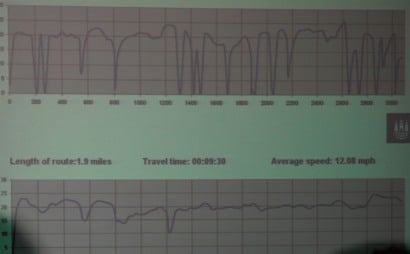
Have you ever heard of Copenhagen’s “green wave”. This is essentially a traffic signal system that is set specifically for bike speed so that, if you ride the prescribed speed, you will hit nothing but green lights. The chart above shows how much smoother bike traffic flow goes on streets where the “green wave” is installed.
And do you recall the first-ever cycle track Portland is planning to build out in the Cully neighborhood? Well, check out this slide for a look at Copenhagen’s cycle track network — over 200 miles strong.
OK, one last slide and then I’m off to a party/reception hosted by the Thunderhead Alliance:
Copenhagen takes the bike-transit connection very seriously. But still, with 500,000 bikes in their city, they can never seem to find enough space to park them all.
At the end of Rohl’s speech, League of American Bicyclists Director Andy Clarke said of Copenhagen; “This is a vision of where we want to get to.”
And the work to get there starts tomorrow morning at 8:00 a.m.
Stay tuned for more coverage of the 2009 National Bike Summit. I’m also posting numerous updates throughout the day on Twitter.


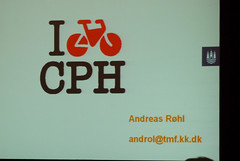

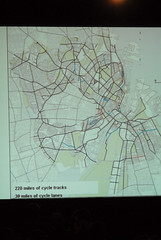
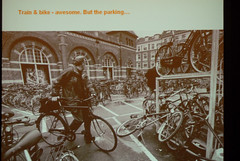
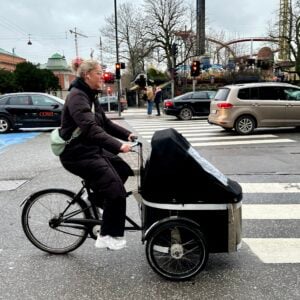
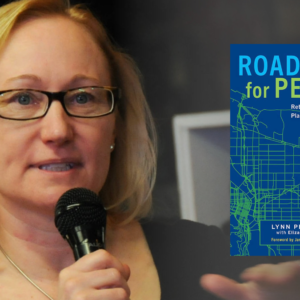

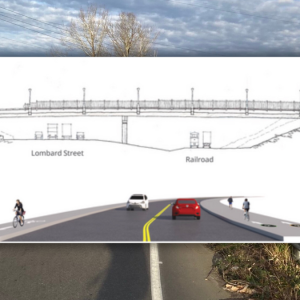
Thanks for reading.
BikePortland has served this community with independent community journalism since 2005. We rely on subscriptions from readers like you to survive. Your financial support is vital in keeping this valuable resource alive and well.
Please subscribe today to strengthen and expand our work.
Gee, Mr. Rohl does not like trains in his city! When I and others have questioned this cities infatuation with street cars and trains there has been a general anger that we could be so backward! Apparently we are not alone when the bicycling capital of the world doesn’t want them! THEY ARE A HAZARD TO CYCLISTS AND ARE ONLY FOR PEOPLE TOO LAZY TO WALK A FEW BLOCKS! There I said it, I know a lot of people on this site are Adam’s sycophants but bicycles and rails in the street do not mix. Electric buses are just as good!
Actually, there are a couple of streets in downtown Portland with a ‘green wave’ for bicyclists, even though it isn’t recognised as such:
SW Main and SW Madison in relation to Hawthorne bridge and SW 4th to Chinatown.
… SW 3rd
I think this is one of the most important points in the whole thing – we in the US make bicycling out to be this dangerous thing that you have to be talented and experienced and ready for danger to participate in, and people are really, honestly scared of something that has such a low danger rate compared to that of driving. I think a lot of it here has to do with liability (for instance, companies putting big WARNING stickers on their bikes and making their owners’ manuals just long strings of WARNING paragraphs about how if you don’t do everything just right, you could crash and hurt yourself). But the reality is, if we encourage more people to ride bicycles, we will have a much safer society. Cycling is not inherently dangerous.
http://www.portlandize.com/2009/03/are-you-afraid-of-your-bicycle.html
http://www.portlandize.com/2009/03/are-you-still-scared-of-your-bicycle.html
@old&slow: He’s talking about their metro system which is used for longer distances, not going 2 blocks, and they don’t run in the streets. There are no streetcars (trams) in Copenhagen that I’m aware of. Bicycles and rails mix just fine if you don’t ride on them and cross them appropriately! There are times when it’s appropriate to ride a train, and there are times when it’s appropriate to bike.
I think another important thing about looking at other places where cycling is a common thing, is to note not only that many people ride to work on a bike, but many people do all their traveling around the city by bike – grocery shopping, taking kids to school, taking mail to the post office, shopping for clothes, whatever. When you need to go anywhere at all, the natural reaction is to hop on your bike. That takes a bit of a different mindset than just getting to work and back.
I agree with Dave (#4), but I think he underemphasizes the role liability plays. Those dire warning stickers don’t just cover bikes, they’re everywhere. By and large, I don’t think the stickers are there to actually convey information to the reader. They are there purely to provide legal CYA for the manufacturer. Those stickers are the tip of cultural iceberg that contains ideas about personal responsibility, our legal system, personal greed and self entitlement, and a host of other things. Getting those stickers off is going to require a lot of major social change.
DC biker here –
This post makes me sad; I doubt we’ll ever see this in our lifetime. But totally agree with the identifiers comment in your post. I am a “cyclist” and you are a “cyclist” and jim over there “is a (dbag) motorist.” too many labels, not enough life and living.
I’ll tell you what I’m sick of: pedaling my ass off on Pennsylvania Ave at 730 in the morning just to not get run over by some a hole going 40, downtown, in the heart of our nation’s capitol. Every morning. and I know what they’re thinking too: who is this a hole on a bike? why is he slowing everything down?
I know it is so uncool/counterproductive, but DC (to name one city) needs a siginificant uptick in militancy. A few key blocked intersections and solid turnout, some uproarious protest, and the city will stop bending over to suburban commuters and all their glass and steel.
For those of you that don’t know: there is a four lane highway immediately (like 60 feet) south and north of the capitol. A massive surface parking lot sits adjacent to the train station, a short walk from the capitol. cars as far as the eye can see.
Hopefully you guys are faring better out there. we do have a good metro though. No bikes during rush hour.
Cycling is a safe, healthy activity.
Wear a helmet or you WILL die!
Why is it difficult to persuade Americans to cycle to work?